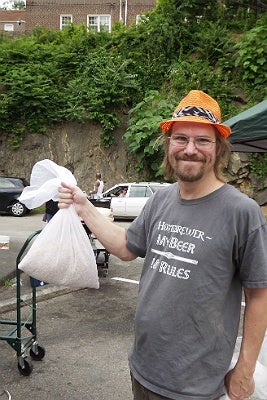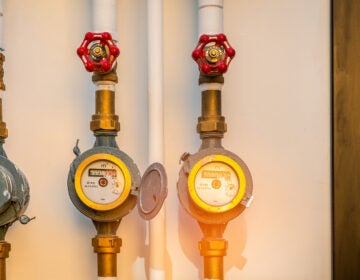Did Philly Beer Week leave you feeling like a want-to-be brewer?
If Philly Beer Week has left you thirsty for brewing knowledge, then Mt. Airy’s Malt House, located at 7101 Emlen St., can help you get started on crafting your own home brew.
Scott Wikander, owner of Malt House, participated in the Trolley Car Diner’s Beer-B-Q festival in honor of Philly Beer Week. During the event, he demonstrated brewing while giving tips to the public.
“I’ve always thought of myself as a teacher – a big part of my goal is education,” said Wikander. “I want to help people learn about beer and brewing and how easy it can be – I want to demystify brewing.”
With a propane burner, a six-gallon pot, malt extract and hops, Wikander was ready to brew on-sight. Home brewers typically use their home stove to brew. For this batch of dry, hopped beer, he used five gallons of water.
Equipment:
– Large pot: Malt House carries pots that can hold a few gallons.
– Thermometer: A floating thermometer is recommended.
– Netted bag: This will hold mixture while it sits in boiling water.
– Strainer: This will be used to strain the mixture after it is taken out of the pot.
– Immersion wort chiller: This device allows the mixture to cool and be siphoned into a fermentation bucket.
– Fermenting bucket: This plastic bucket must have a lid and an air lock and stopper to keep your brew sealed airtight. The bucket will host your beer for the days or weeks of fermentation.
– Bottles: You will need about two cases of 12 ounce bottles for a five-gallon batch. Wikander also recommends utilizing a keg to avoid the bottling process.
– Tubing: A tube will be used to siphon and bottle the beer.
– Sanitizing solution: Supply stores carry iodophor and starsan to clean equipment before and after use. “The biggest thing I always tell people is just be clean,” said Wikander. “When I work I keep a little bucket of sanitizer nearby because nine times out of 10 if your beer doesn’t come out good it’s because you weren’t clean.”
Ingredients:
* Please note this is for a 5-gallon batch.
– 4 to 5 lbs of malted barley
– 3 lbs of malt extract (also known as malted grain)
– 2 ounces of hops: Wikander says you can grow hops in your yard, as he does, or buy pre-packaged pelleted hops.
– 1 package of yeast
– 3/4 cup sugar: Many brewers use corn sugar.
Steps:
Step 1: In your pot, boil water to about 150 degrees. Add in malt extract and hops (in a netted bag if desired) and allow them to steep for about 45 minutes. “This will extract the sugar from the grain, which is what creates alcohol,” said Wikander.
Step 2: Pull the netted bag out to strain it. Then rinse off the mixture with water. Wikander says in brewing lingo this mixture is called “wort.” He recommends adding more hops and re-boiling the mixture for about 10 minutes to get a more flavorful beer. “It’s a creative process. There’s different types of yeast and hops that make interesting flavor combinations – like adding seasoning spices, honey or other types of sugar like lactose – which is like a milky sugar.”
Step 3: Next, transfer the mixture through a device called an immersion wort chiller. By attaching the device’s tube to a spout you can pump cold water through the coil. “This will create a heat transference,” said Wikander.
Step 4: Finally, siphon the mixture into fermentation bucket and siphon additional water into the bucket until it is filled to desired amount. Add yeast to start the fermentation bucket. Wikander says remember to let your refrigerated yeast set for a few hours before use so that it becomes active. Allow beer to ferment for at least one week before drinking. Wikander says the length a beer ferments is the brewer’s decision.
Step 5: After desired fermentation time has passed, add more sugar into the bucket and stir the mixture. Then, siphon beer into bottles or a keg and let it sit in a cool, dry place. Once bottled, Wikander recommends waiting two to six weeks to allow yeast to ferment the remaining sugar, which will create carbon dioxide to carbonate your beer.
Step 6: Refrigerate your beer for a few hours and enjoy!
Tips from a home brewer:
Wikander says he’s no master brewer, and that helps him relate to beginners better. He says brewing is something that people have been doing for thousands of years and it’s not as difficult as people may think.
“Brewing beer can be as complicated as you want to make it or it can be as simple as making soup,” said Wikander.
He estimates that basic brewing equipment like a large pot, siphoning system, fermentation bucket and sanitizer will cost about $125.
Brewing ingredients like yeast and malt extract can be bought at any home brewing store, and he says most people start with extract brewing.
“Extract brewing eliminates that mashing process because they’ve done the mashing for you,” said Wikander. “They’ve even pulled the sugar out of the grain.”
He says the process itself is relatively fast.
“From start to finish the brewing process takes about two hours and the fermentation process is about a week.”
Wikander recommends against pre-packaged home brew kits like a Mr. Beer.
“They’re mass-produced in a factory,” said Wikander. “By the time you get it you don’t know how old they are and the ingredients in the yeast could be ancient. I’ve been called a beer snob for 20 years now. I don’t think there’s anything wrong with preferring quality.”
He says the creative and experimental aspects of brewing are what draw people to the craft.
“It’s pride in ownership. There’s a sense of satisfaction when you know you made it yourself from scratch,” said Wikander, “you know the ingredients were fresh and no strange chemicals were added.”
Wikander is available at Malt House during business hours and he also hosts brewing classes at the Mt. Airy Learning Tree.
Malt House is located at 7101 Emlen Street in Mt. Airy.
WHYY is your source for fact-based, in-depth journalism and information. As a nonprofit organization, we rely on financial support from readers like you. Please give today.













